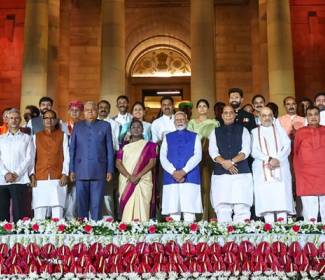The 29th Conference of Parties (COP29) to the United Nations Framework Convention on Climate Change (UNFCCC) has recently concluded with pivotal agreements and intense debates at Baku.
Held under the vision of intensifying climate crises and geopolitical tensions, COP29 has marked yet another milestone in global climate diplomacy. The conference focused on implementing the Paris Agreement—enhancing climate finance and addressing global disparities in climate responsibilities and capacities—with attending stakeholders ranging from governments to non-state actors.
The two standout issues were operationalising Article 6.4 of the Paris Agreement—centred on carbon markets—and setting a new global climate finance target under the New Collective Quantified Goal (NCQG). Both these discussions have underscored the disparity between developed and developing economies in tackling climate challenges.
This comprehensive analysis delves into the key outcomes of COP29, emphasising the implications for India in leveraging these outcomes for sustainable development and economic growth.
What’s Article 6.4 of the Paris Agreement?
Article 6 of the Paris Agreement lays the foundation for international cooperation through carbon markets and other mechanisms to achieve climate goals cost-effectively. Specifically, Article 6.4 establishes a centralised carbon market mechanism under UN oversight. This system allows emissions reduction projects to generate tradable carbon credits, encouraging investments in sustainable development worldwide.
The mechanism includes strict environmental and social safeguards to ensure transparency, prevent double counting and protect the rights of indigenous and local communities. Additionally, Article 6.4 seeks to standardise carbon market operations, offering a globally consistent framework for pricing carbon credits. This uniformity fosters trust and predictability, enabling credits to function as a reliable medium of exchange across international markets.
Approval of Article 6.4
The parties reached a consensus on a set of standards under Article 6.4 to boost the global carbon market and ensure the integrity of these projects. This lays the foundation for the establishment of global mechanisms for reducing greenhouse gas (GHG) emissions through a cooperative approach involving the public and private sectors. This market-based mechanism allows countries to trade carbon credits generated while adhering to robust standards. COP29 has finalised key rules and safeguards to ensure transparency, avoid double counting of credits and support sustainable development.
“India’s deep-tech solutions, including digital MRV systems, blockchain, satellite monitoring and AI, ensure high-quality carbon credits by enhancing accuracy, transparency and accountability. Supported by robust government policies, these technologies contribute significantly to global climate goals,” says Sujatha UG, Vice President, Global Partnerships at Invest India.
Benefits of Article 6.4 for India
- Relevance to India’s carbon markets
India, as a rapidly growing economy with ambitious climate targets under its Nationally Determined Contributions (NDCs), stands to benefit significantly from the operationalisation of Article 6.4. The country has been advancing its domestic carbon market framework and COP29’s decisions align with its priorities to monetise emission reductions while ensuring environmental integrity.
The India Carbon Markets (ICM), proposed under the Carbon Credit Trading Scheme for Decarbonisation, may integrate with the global carbon market registries with the new globally accepted standards.
- Harmonising the price of carbon credits
One notable advancement under Article 6.4 is the standardisation of carbon market registries, which promises to harmonise the pricing of carbon credits across global markets. This uniformity could make carbon credits a viable medium of exchange, streamlining international trade and enhancing market efficiency. For India, this standardisation offers several advantages:- Price stability: Ensures that Indian carbon credits, especially from renewable energy and reforestation projects, receive competitive and fair pricing
- Enhanced market confidence: A standardised system attracts investors by reducing transaction risks and creating predictable market dynamics
- Integration into global trade: By aligning with international norms, Indian businesses can seamlessly trade carbon credits, fostering economic integration
“India’s carbon credit market can thrive under COP29’s Article 6.4 by attracting global investments through high-quality credits verified by advanced technologies like blockchain and AI. The establishment of a unified Indian Carbon Market and strong government policies will enhance trading opportunities. This integration into global carbon markets will boost capital inflows, support renewable energy projects and contribute significantly to global climate goals and sustainable development,” she adds.
NCQG on climate finance
The NCQG on climate finance represents an evolution of the global financial framework under the UNFCCC. This focuses on scaling up resources to address the growing demands of climate mitigation, adaptation and resilience-building, especially in developing countries. It replaces the previous $100-billion annual target set at COP15 in Copenhagen in 2009, which was intended to be achieved by 2020.
The NCQG aims to replace the previous $100 billion annual commitment from developed countries, which was never fully realised. At COP29, parties agreed on a new target of $300 billion annually by 2035, a step forward but significantly below the $1.3 trillion per year demanded by developing nations.
The NCQG also includes a focus on adaptation finance, an area of vital importance for countries like India that face escalating climate vulnerabilities. However, the lack of specificity regarding the sources and mechanisms of this finance remains a major concern.
NCQG: A lost opportunity
Though NCQG is considered a lost opportunity, the $300 billion pledge represents a rise. However, it does fall drastically short of the $1.3 trillion annually requested by developing nations to meet their mitigation and adaptation needs. This disparity highlights the persistent gap in climate responsibilities and capacities.
Independent estimates suggest that actual global climate finance requirements could be between $4 trillion to $7 trillion annually by 2030 as per various studies. The agreed target risks being inadequate for addressing the intensifying climate crisis.
A critical shortfall of the NCQG lies in its vagueness regarding the sources of funding. Reliance on private sector financing, while substantial, is uncertain and cannot be guaranteed, leaving room for business-as-usual approaches to be falsely categorised under climate finance.
Opportunities for India under NCQG
Despite its limitations, the NCQG presents significant opportunities for India. India’s demonstrated leadership in renewable energy, energy efficiency and large-scale adaptation projects makes it a preferred destination for climate finance among developing economies.
Also, at COP29, the stakeholders have agreed to work together to scale up finance to developing countries, from public and private sources, to the amount of $1.3 trillion per year by 2035.
India’s robust policy framework, ease of doing business and large consumer base make it a prime choice for private investors compared to other developing economies. Leveraging NCQG could further enhance India’s ability to attract concessional loans, grants and equity investments for transformative climate projects.
“India’s commitment to climate action is unwavering, and the outcomes of COP29 underscore the critical need for substantial climate investments. With the new global climate finance target aiming to mobilise $1.3 trillion annually by 2035, including $300 billion from developed nations, India stands poised to leverage these funds to drive sustainable development and resilience. This financial support is essential for India to meet its ambitious climate goals and transition towards a greener, more sustainable future,” she says.
Need for south-south cooperation
The COP29 outcomes underscore the urgency for developing nations to strengthen south-south cooperation to counterbalance the dominance of developed economies in climate negotiations. Collective efforts by the global south can help:
- Advocate for more ambitious climate finance targets
- Ensure equitable distribution of funds aligned with the specific needs of developing countries and
- Push for mechanisms that address loss and damage effectively
India, as a leader among developing economies, can play a pivotal role in fostering this cooperation—particularly, through platforms like the G20, IPEF and BRICS.
Leveraging the Baku-to-Belem roadmap
The roadmap from Baku to Belém incorporates key milestones like the Global Stocktake 2025, a critical assessment of global progress towards the goals of the Paris Agreement and highlights key priorities for catalysing climate finance.
India can leverage this framework by:
- Building coalitions with like-minded nations to push for clearer mechanisms and accountability in climate finance
- Advocating for innovative financing instruments, such as climate bonds and blended finance models, to supplement traditional funding sources and
- Showcasing its success stories in renewable energy and adaptation projects to attract further investments
COP29 brought both progress and challenges, particularly for developing nations like India. The operationalisation of Article 6.4 offers a significant opportunity to enhance India’s carbon market landscape and support nature-based solutions.
“Nature-based solutions, such as reforestation and wetland restoration, boost India’s economy by enhancing ecosystem services, creating green jobs and attracting climate investments. These sustainable practices support agriculture, fisheries and tourism while mitigating climate risks and promoting biodiversity, leading to long-term economic resilience and growth,” she says.
However, the NCQG on climate finance falls short of the needs articulated by developing economies, necessitating further negotiation and collaboration.
India stands at a unique juncture where it can leverage international climate finance while also advocating for a fairer and more effective global system. India is aligning its domestic policies with global goals and fostering south-south cooperation to emerge as a leader in the global fight against climate change, turning challenges into opportunities for sustainable growth.
“For example, India’s mangrove cover has increased by 17 square kilometres in 2024. The government has launched impactful initiatives like the Mangrove Initiative for Shoreline Habitats & Tangible Incomes (MISHTI) and the National Coastal Mission Programme to strengthen the mangrove ecosystem. The sector, however, requires derisking capital to ensure the long-term sustainability of the projects. This is where international investments can act as a multiplier, significantly boosting the scale and impact of such green moves. Thus, India should leverage global platforms like COP29 to attract international financing to meet the significant funding gaps,” she concludes.
- https://pib.gov.in/PressReleaseIframePage.aspx?PRID=2037660
- https://pib.gov.in/PressReleasePage.aspx?PRID=1923458
- https://unfccc.int/news/cop29-un-climate-conference-agrees-to-triple-finance-to-developing-countries-protecting-lives-and
- https://about.bnef.com/blog/the-7-trillion-a-year-needed-to-hit-net-zero-goal/
- https://iea.blob.core.windows.net/assets/deebef5d-0c34-4539-9d0c-10b13d840027/NetZeroby2050-ARoadmapfortheGlobalEnergySector_CORR.pdf







